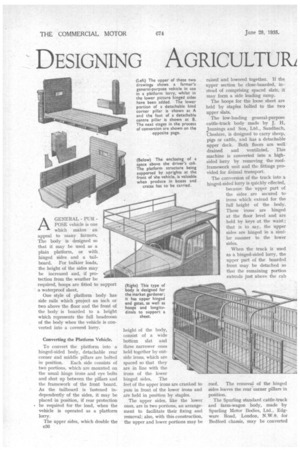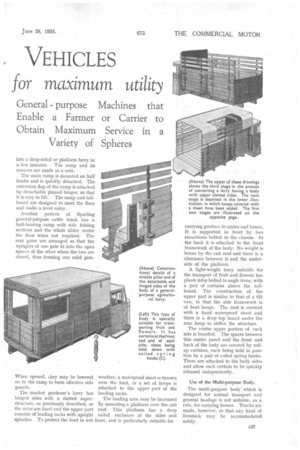DESIGNING AGRICULTUR)
Page 86

Page 87

Page 88

If you've noticed an error in this article please click here to report it so we can fix it.
VEHICLES
for maximum utility
General purpose Machines that Enable a Farmer or Carrier to Obtain Maximum Service in a Variety of Spheres AGENERAL PUR POSE vehicle is one which makes an appeal to many farmers. The body is designed so that it may be used as a plain platform, or with hinged sides and a tailboard. For bulkier loads, the height of the sides may be increased and, if protection from the weather be required, hoops are fitted to support a waterproof sheet.
One style of platform body has side rails which project an inch or two above the floor and the front of the body is boarded to a height which represents the full headroom of the body when the vehicle is converted into a covered lorry.
Converting the Platform Vehicle.
To convert the platform into a hinged-sided body, detachable rear corner and middle pillars are bolted in position. Each side consists of two portions, which are mounted on the usual hinge irons and eye bolts and shut up between the pillars and the framework of the front board. As the tailboard is fastened independently of the sides, it may be placed in position, if rear protection • be required for the load, when the vehicle is operated as a platform lorry.
The upper sides, which double the c36 height of the body, consist of a wide bottom slat and three narrower ones held together by outside irons, which are spaced so that they are in line with the irons of the lower hinged sides. The feet of the upper irons are cranked to pass in front of the lower irons and are held in position by staples.
The upper sides, like the lower ones, are in two portions, an arrangement to facilitate their fixing and removal; also, with this construction, the upper and lower portions may be
raised and lowered together. If the upper section be close-boarded, instead of comprising spaced slats, it may form a side loading ramp.
The hoops for the loose sheet are held by staples bolted to the two upper slats.
The low-loading general-purpose cattle-truck body made by J. H. Jennings and Son, Ltd., Sandbach, Cheshire, is designed to carry sheep, pigs or cattle, and has a detachable upper deck. Both floors are well drained and ventilated. This machine is converted into a highsided lorry by removing the roofframework unit and the fittings provided for animal transport.
The conversion of the truck into a hinged-sided lorry is quickly effected, because the upper part of the sides are secured to irons which extend for the full height of the body. These irons are hinged at the floor level and are held by keys at the waist ; that is to say, the upper sides are hinged in a similar manner to the lower sides.
When the truck is used as a hinged-sided lorry, the upper part of the boarded front may be detached so that the remaining portion extends just above the cab roof. The removal of the hinged sides leaves the rear corner pillars in position.
The Spurling standard cattle-truck and farm-wagon body, made by Spurling Motor Bodies, Ltd., Edgware Road, London, N.W.9, for Bedford chassis, may be converted into a drop-sided or platform lorry in a few minutes. The ramp and its runners are made as a unit.
The main ramp is mounted on half hooks and is quickly detached. The extension flap of the ramp is attached by detachable pinned hinges, so that it is easy to lift. The ramp and tailboard are designed to meet the floor and make a level entry.
Another pattern of Spurling general-purpose cattle truck has a ball-bearing ramp with side folding sections and' the whole slides under the floor when not required. The rear gates are arranged so that the uprights of one gate fit into the open spaces of the other when the two are closed, thus forming one solid gate, When opened, they may be lowered on to the ramp to form effective side guards.
The market gardener's lorry has hinged sides with a slatted superstructure, as previously described, or the sides are fixed and the upper part consists of loading racks with upright spindles. To protect the load in wet
weather, a waterproof sheet Is thrown over the load, or a set of hoops is attached to the upper part of the loading racks.
The loading area may be increased ty mounting a platform over the cab roof. This platform has a deep railed enclosure at the sides and front, and is particularly suitable for carrying produce in crates and boxes. It is supported in front by two stanchions bolted. to the chassis. At the back it is attached to the front framework of the body. No weight is borne by the cab roof and there is a clearance between it and the under side of the platform.
A light-weight lorry suitable for the transport of fruit and flowers has plank side p bolted to angle irons, with
a pair of curtains above the tail
board. The construction of the upper part is similar to that of a tilt van, in that the side framework is of bent hoops. The roof is covered with a fixed waterproof sheet and there is a deep top board under the rear hoop to stiffen the structure.
• The centre upper portion of each side is boarded. The spaces between this centre panel and the front and back of the body are covered by rollup curtains, each being held in position by a pair of coiled spring hooks. These are attached to the bo4 sides and allow each curtain to be quickly released independently.
Use of the Multi-purpose Body.
The multi-purpose body which is designed for animal transport and general haulage is not suitable, as a rule, for carrying horses. Trucks are made, however, so that any kind of livestock may be accommodated safely. The Jennings rigid-sided combined horsebox and cattle truck has rear and side-loading ramps. Detachable fittings and pailding are provided for three horses. When these fittings are removed, an upper deck may be fitted for sheep and pigs, or if cattle are to be carried, then the top deck is stowed away under the roof, leaving sufficient headroom for the animals.
The vehicle designed for carrying only horses has stalls, which face the rear, for two or three animals in the forward half of the body. The horses are loaded and unloaded from the side, or there are half-height doors below the mangers, so that the animals may be led out, without turning, from arear ramp, after traversing the grooms' compartment.




























































































































































